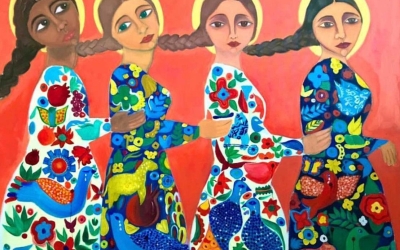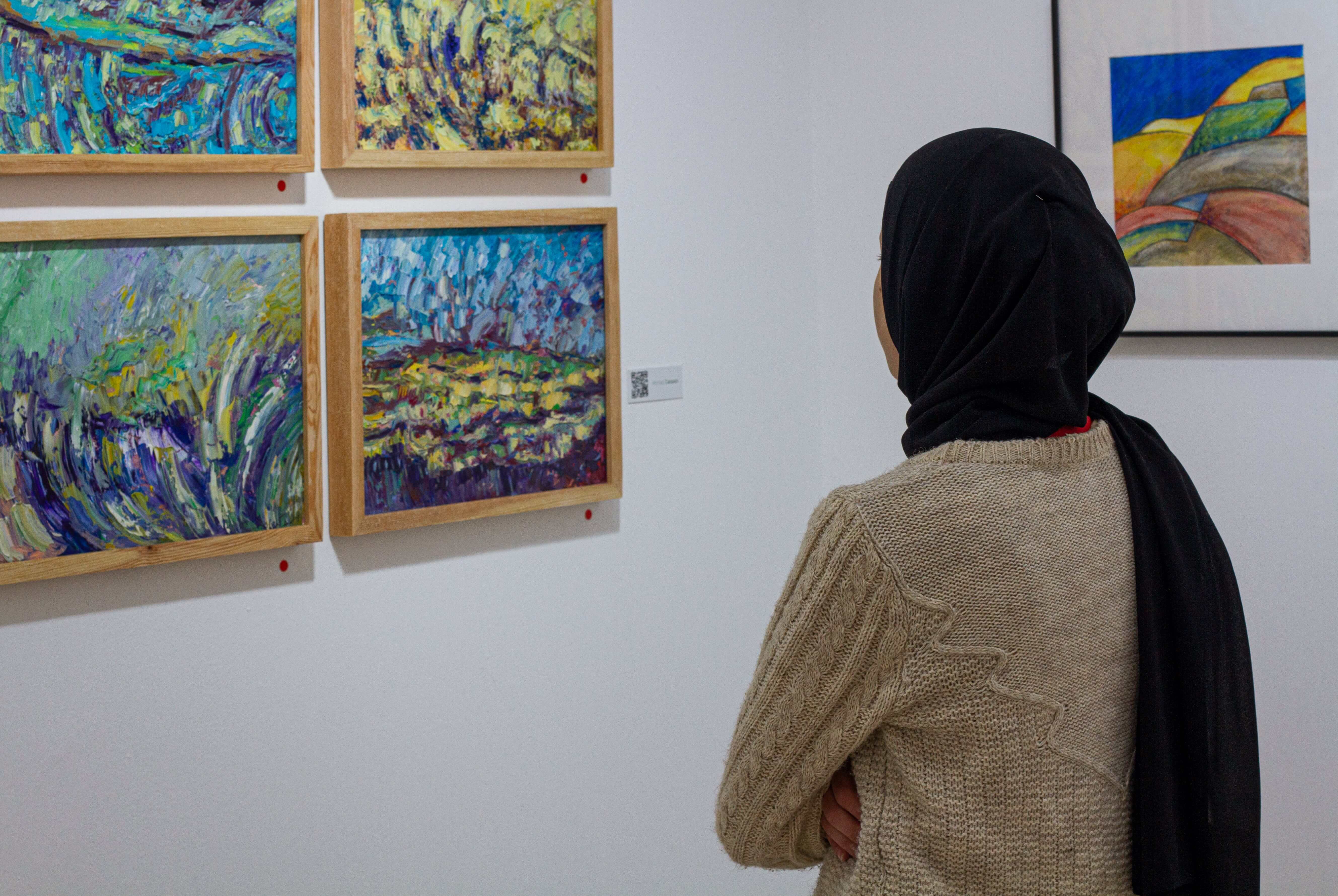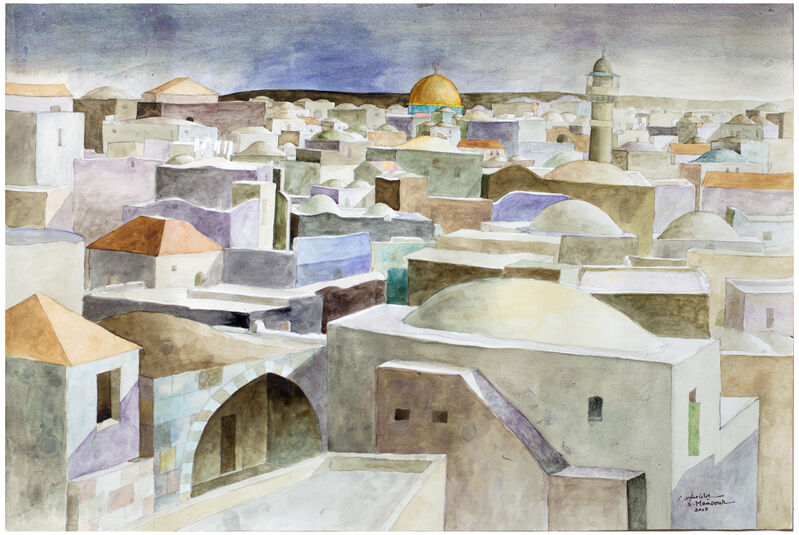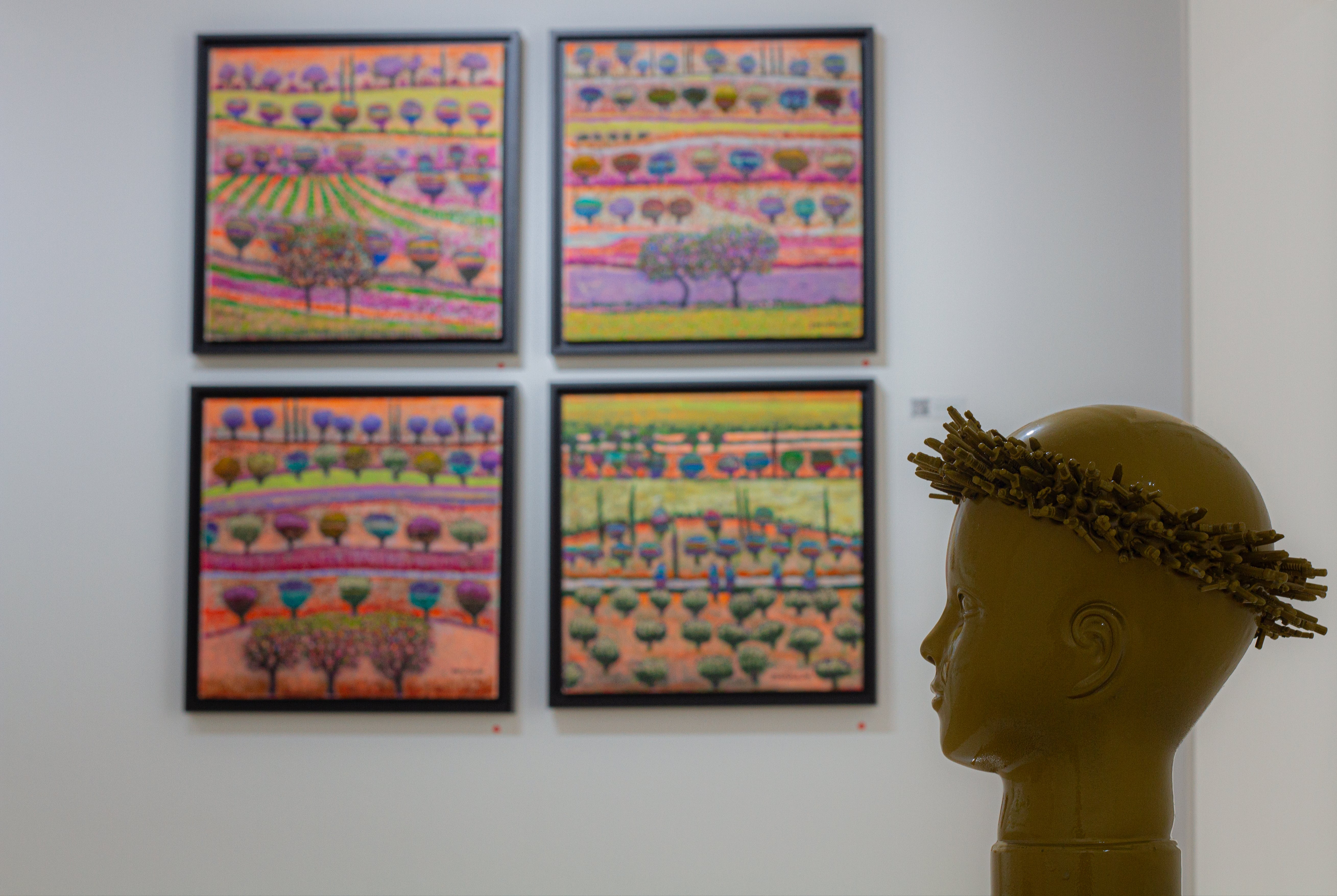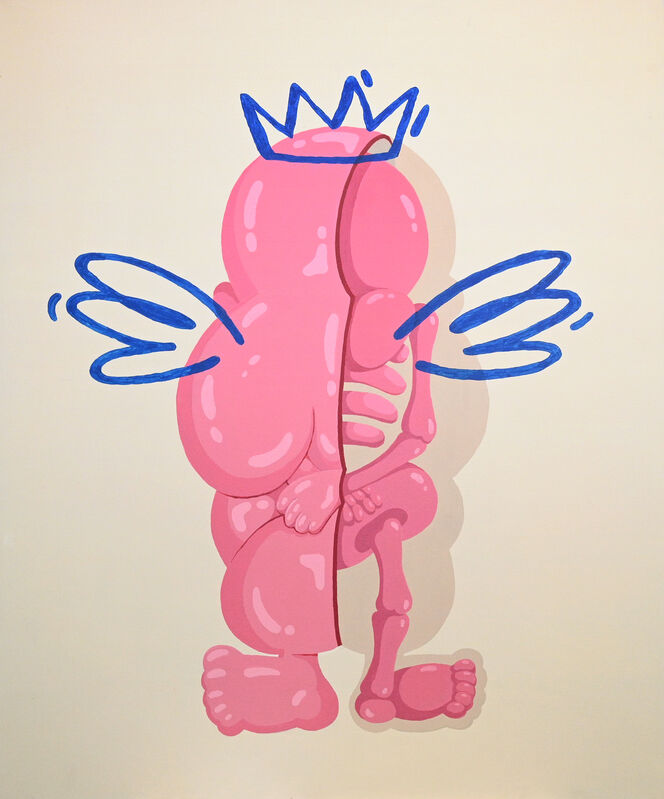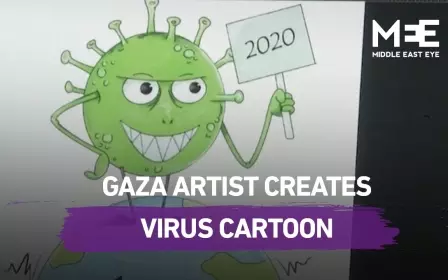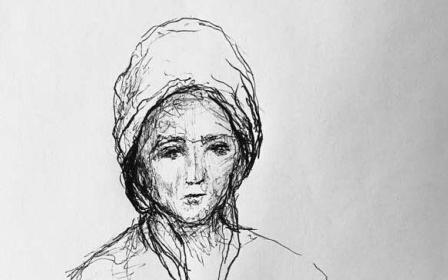Ramallah Art Fair: A Palestinian success amid occupation and pandemic
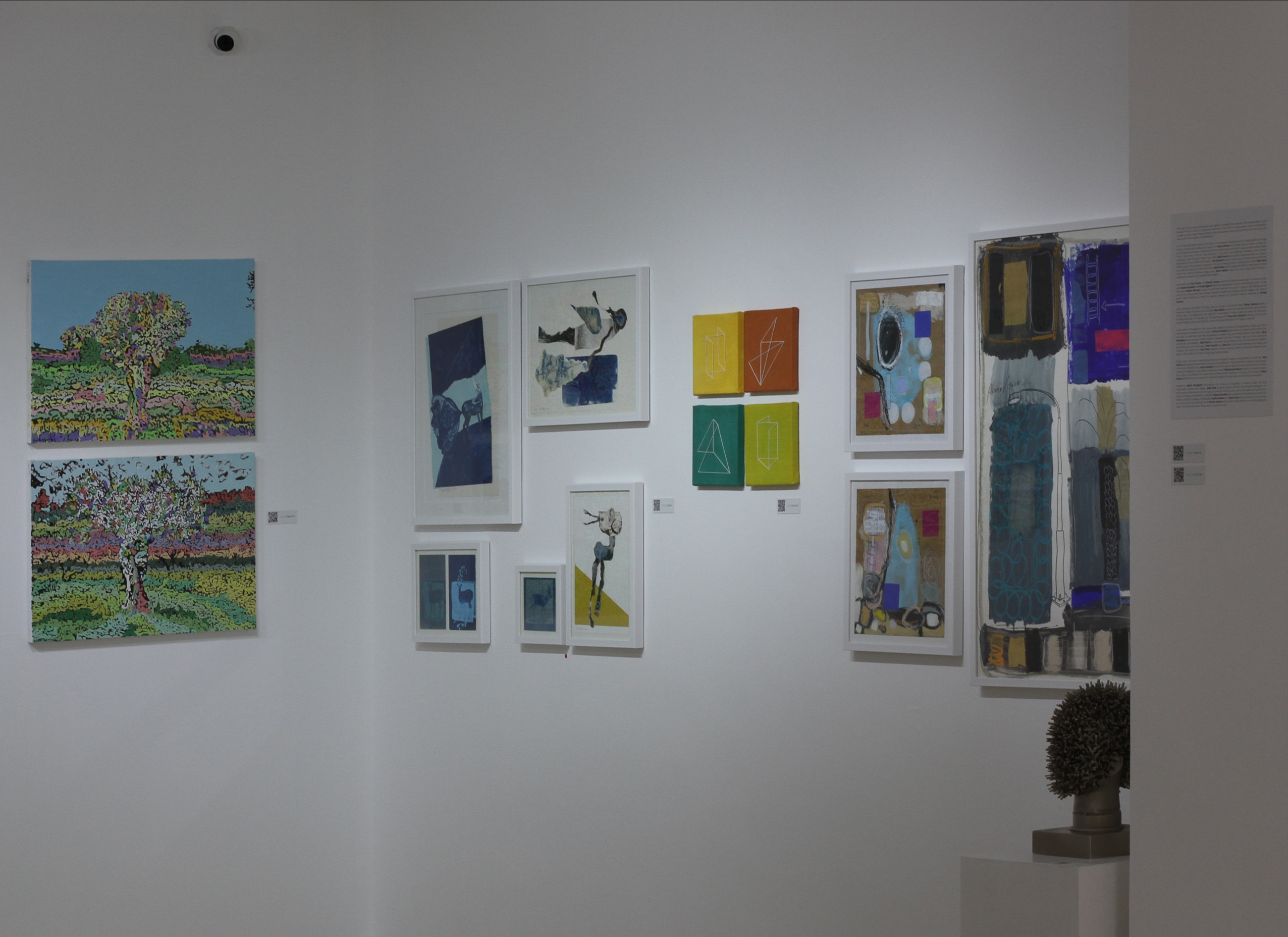
Starting Palestine’s first ever art fair during a global pandemic may seem a daunting proposition, but for Ziad Anani and Yusef Hussein, of the Zawyeh Art Gallery, it was a much needed way to bring Palestinians together in testing times.
"The Ramallah Art Fair wasn’t something we started despite the pandemic. It was something we started because of it," says Hussein, who is gallery manager at Zawyeh in the occupied West Bank city of Ramallah.
New MEE newsletter: Jerusalem Dispatch
Sign up to get the latest insights and analysis on Israel-Palestine, alongside Turkey Unpacked and other MEE newsletters
He tells Middle East Eye that the decision to organise the fair was made as much of the art world was going online to comply with social distancing measures.
"We decided to go against the grain and in this way support local artists, as well as finding a cohesive way to get the gallery going."
The first edition was staged between December 2020 and March 2021 and featured 26 artists from Palestine. The second, running until 15 February, will include over 30 Palestinian artists, who range from the young and emerging to well-known pioneers, living in Palestine and the diaspora.
Also featured are artists from the occupied Syrian Golan, Lebanon, and Turkey. Most of the artworks were produced specifically for the fair.
Artist Suleiman Mansour says the fair is a good opportunity for young artists to make an impression and present their work to the public.
"This edition of the Ramallah art fair is focused on smaller, more affordable pieces, so for the established artists it's an opportunity to make more contained but good quality works, using a variety of mediums, including traditional ones," Mansour explains.
He exhibited two watercolour pieces at this year's fair – one of Jerusalem, and a preparatory sketch for a mural.
'Special character'
The fair has garnered widespread support, both from contributing artists and the public, who have hailed the decision to launch the fair during a pandemic as "courageous".
Hussein was determined that the fair should distinguish itself from other international exhibitions. Whereas most international art fairs are getting bigger, and more similar in style, the organisers of the Ramallah Art Fair were keen to deliver something different, paying particular attention to the atmosphere and on including a wide array of artists.
“The intimacy of the Ramallah Art Fair is what gives it a special character,” says artist Vera Tamari, who participated in the fair with three of her abstract landscapes.
Although the Zawyeh Gallery is not expansive, the location holds a particular significance for the local community. The building is the former house of Nabil Anani, an artist and the father of Ziad Anani, the founder and director of Zawyeh.
And whereas most art fairs typically last up to five days, the Ramallah Art Fair lasts over two months, as it aims to draw in as many visitors from across Palestine.
Organisers have also opted to include a range of styles and encouraged a high level of experimentation by the artists.
'We had to keep reprinting the sale sheets, as the best works were selling out five days before the official opening'
- Yusef Hussein, gallery manager
Although paintings are usually the most popular and most collectable type of art, this exhibition showcases photography, collages, sculptures and sketches.
Art is notoriously expensive, but the organisers wanted to keep prices affordable for a wider range of people. Pieces cost from as little as $10 and go all the way up to $2,000.
"The response from collectors has been great," says Hussein. "In the first edition of the fair, 30 percent of the works sold online before the fair actually opened. The collectors and the public were excited. The Palestine art scene is very small, and this kicked off some momentum, despite the uncertainty of the pandemic.
“We had to keep reprinting the sale sheets, as the best works were selling out five days before the official opening."
For its organisers, the Ramallah Art Fair is also a chance to shift perceptions of art within the country.
“Becoming an artist here is still not seen as a respectable profession,” Hussein tells MEE. “We want to encourage collectors to collect here in Palestine, to invest locally, as we see such incredible talent here."
With a new branch of the Zawyeh Gallery in Dubai, Hussein says the appeal of the art on display at the fair extends beyond Palestine and the diaspora.
Reemm Renno, a New York-based collector, says she has started gravitating more towards art made by Palestinian artists.
"It somehow speaks to my awareness of this ongoing human struggle, and I deeply feel for the cause of this last settler-colonialised land," she says.
Renno says she chooses her art based on aesthetics and emotions, with her personal collection including pieces by artists including Hazem Harb, Larissa Sansour, Bashar Hroub and Mona Hatoum.
Walking away with two purchases from the fair, Renno says that the exhibition symbolises Palestinian "resilience".
"It is amazing to witness an art fair born in the midst of a global pandemic and in the worst living conditions for Palestinians under occupation. I see it as a glimpse of hope and a sign of resilience. It confirms to me that human creativity peaks in the worst of moments.”
The challenges of occupation
Despite the success of the fair, organisers and artists alike maintain that one of the biggest challenges they face is the ongoing occupation.
“The mobility between the areas is hampered by the occupation," says Tamari. "Perhaps an option in our particular situation could be a parallel active online art fair with information on the artworks, interviews with artists, and some debate,” she suggests.
Transporting the art around the occupied territories, past numerous Israeli checkpoints and custom checks, was one of the most challenging aspects for the organisers. Nevertheless, as an inextricable aspect of the Palestinian experience, the occupation inevitably influences the art on show; it can be seen, even to a subtle degree, in both physical and abstract ways.
One such example is Saher Nassar’s The Eternal, the artist’s tribute to Naji al-Ali, the Palestinian cartoonist famous for his criticism of Arab regimes and Israel, who was assassinated in London in 1987.
Ali is perhaps most famous for his iconic "Handala" image of a back-facing Palestinian child, for ever stuck at the age of his expulsion from Palestine, dishevelled but nevertheless defiant.
“Every Palestinian knows his character, Handala, who became a symbol for resistance and outrage in the face of injustice," Nassar says. "I simply created a version of Handala that humanises him by giving him a body foundation, yet I gave him wings of immortality."
For Nassar, as with the other participants, the symbolic resilience of Handala is reflected in the flourishing of Palestinian culture despite the impediments of occupation.
“It’s the fact that the fair is happening in a region with that much conflict, which makes it all the more important as a platform for artists to express their thoughts globally."
Middle East Eye delivers independent and unrivalled coverage and analysis of the Middle East, North Africa and beyond. To learn more about republishing this content and the associated fees, please fill out this form. More about MEE can be found here.


